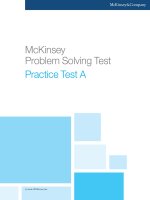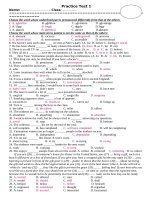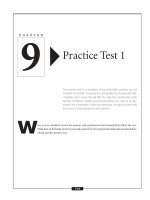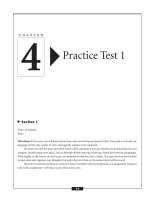GRE practice test 1 quant 18 point
Bạn đang xem bản rút gọn của tài liệu. Xem và tải ngay bản đầy đủ của tài liệu tại đây (1.42 MB, 76 trang )
GRADUATE RECORD EXAMINATIONS®
Practice General Test # 1
Large Print (18 point) Edition
Section 3—Quantitative Reasoning
Section 4—Quantitative Reasoning
Copyright © 2009 by Educational Testing Service. All
rights reserved. ETS, the ETS logo, GRADUATE RECORD
EXAMINATIONS, and GRE are registered trademarks of
Educational Testing Service (ETS) in the United States and
other countries.
752505
Revised Graduate Record Examinations General Test
Practice Test # 1
Instructions for the Verbal Reasoning and Quantitative
Reasoning Sections
For your convenience, these instructions are included both in the test
book for Sections 1 and 2, and in the test book for Sections 3 and 4.
The instructions are the same in both locations.
As a reminder, standard timing for each section of the test is shown
in the table below:
Section Order
Analytical Writing 1
Analytical Writing 2
1
2
3
4
Section Name
Analyze an Issue
Analyze an Argument
Verbal Reasoning
Verbal Reasoning
Quantitative Reasoning
Quantitative Reasoning
Standard Time
30 minutes
30 minutes
35 minutes
35 minutes
40 minutes
40 minutes
GO ON TO THE NEXT PAGE.
-2-
Important Notes
In the actual test, your scores for the multiple-choice sections will be
determined by the number of questions you answer correctly. Nothing
is subtracted from a score if you answer a question incorrectly.
Therefore, to maximize your scores it is better for you to guess at an
answer than not to respond at all. Work as rapidly as you can without
losing accuracy. Do not spend too much time on questions that are
too difficult for you. Go on to the other questions and come back to
the difficult ones later.
Some or all of the passages in this test have been adapted from
published material to provide the examinee with significant problems
for analysis and evaluation. To make the passages suitable for testing
purposes, the style, content, or point of view of the original may have
been altered. The ideas contained in the passages do not necessarily
represent the opinions of the Graduate Record Examinations Board
or Educational Testing Service.
You may use a calculator in the Quantitative Reasoning sections
only. You will be provided with a basic calculator and cannot use any
other calculator, except as an approved accommodation.
Marking Your Answers
In the actual test, all answers must be marked in the test book.
The following instructions describe how answers must be filled in.
Your answers will be hand-scored, so make sure your marks are
clear and unambiguous. Examples of acceptable and unacceptable
marks will be given with the sample questions.
GO ON TO THE NEXT PAGE.
-3-
Question Formats
This practice test may include questions that would not be used in an
actual test administered in an alternate format because they have been
determined to be less suitable for presentation in such formats.
The questions in these sections have several different formats. A brief
description of these formats and instructions for entering your answer
choices are given below.
Multiple-Choice Questions—Select One Answer Choice
These standard multiple-choice questions require you to select just
one answer choice from a list of options. You will receive credit only
if you mark the single correct answer choice and no other.
Example:
What city is the capital of France?
A
B
C
D
Rome
Paris
London
Cairo
GO ON TO THE NEXT PAGE.
-4-
Acceptable Marks
A
Rome
A
Rome
A
Rome
B
Paris
B
Paris
B
Paris
C
London
C
London
C
London
D
Cairo
D
Cairo
D
Cairo
A
Rome
A
Rome
A
Rome
B
Paris
B
Paris
B
Paris
C
London
C
London
C
London
D
Cairo
D
Cairo
D
Cairo
A
Rome
B
Paris
C
London
D
Cairo
GO ON TO THE NEXT PAGE.
-5-
Unacceptable Marks
A
Rome
A
Rome
A
Rome
B
Paris
B
Paris
B
Paris
C
London
C
London
C
London
D
Cairo
D
Cairo
D
Cairo
A
Rome
A
Rome
A
Rome
B
Paris
B
Paris
B
Paris
C
London
C
London
C
London
D
Cairo
D
Cairo
D
Cairo
If you change an answer, be sure that all previous marks are erased
completely. Stray marks and incomplete erasures may be read as
intended answers. Blank areas of the test book may be used for
working out answers, but do not work out answers near the answerentry areas. Scratch paper will not be provided, except as an approved
accommodation.
GO ON TO THE NEXT PAGE.
-6-
Multiple-Choice Questions—Select One or More Answer Choices
Some of these questions specify how many answer choices you must
select; others require you to select all that apply. In either case, to
receive credit all of the correct answer choices must be marked.
These questions are distinguished by the use of a square box to be
marked to select an answer choice.
Example:
Select all that apply.
Which of the following countries are in Africa?
A China
B Congo
C France
D Kenya
GO ON TO THE NEXT PAGE.
-7-
Acceptable Marks
A
China
A
China
B
Congo
B
Congo
C
France
C
France
D
Kenya
D
Kenya
A
China
A
China
B
Congo
B
Congo
C
France
C
France
D
Kenya
D
Kenya
Unacceptable Marks
A
China
A
China
A
China
B
Congo
B
Congo
B
Congo
C
France
C
France
C
France
D
Kenya
D
Kenya
D
Kenya
A
China
A
China
A
China
B
Congo
B
Congo
B
Congo
C
France
C
France
C
France
D
Kenya
D
Kenya
D
Kenya
GO ON TO THE NEXT PAGE.
-8-
Column Format Questions
This question type presents the answer choices in columns. You must
pick one answer choice from each column. You will receive credit
only if you mark the correct answer choice in each column.
Example:
Complete the following sentence.
(i) _______ is the capital of (ii)_______.
Blank (i)
Blank (ii)
A
Paris
D
Canada
B
Rome
E
France
C
Cairo
F
China
GO ON TO THE NEXT PAGE.
-9-
Numeric-Entry Questions
These questions require a number to be entered by circling entries in
a grid. If you are not filling in your own answers, your scribe should
be familiar with these instructions.
1. Your answer may be an integer, a decimal, or a fraction,
and it may be negative.
2. Equivalent forms of the correct answer, such as 2.5 and 2.50,
are all correct. Although fractions do not need to be reduced
to lowest terms, they may need to be reduced to fit in the grid.
3. Enter the exact answer unless the question asks you to round
your answer.
4. If a question asks for a fraction, the grid will have a built-in
division slash (/). Otherwise, the grid will have a decimal point.
5. Start your answer in any column, space permitting. Circle no
more than one entry in any column of the grid. Columns not
needed should be left blank.
6. Write your answer in the boxes at the top of the grid and circle
the corresponding entries. You will receive credit only if your
grid entries are clearly marked, regardless of the number
written in the boxes at the top.
GO ON TO THE NEXT PAGE.
- 10 -
Examples of acceptable ways to use the grid:
Integer answer: 502 (either position is correct)
–
.
0
1
2
3
4
5
6
7
8
9
5
0
2
.
0
1
2
3
4
5
6
7
8
9
.
0
1
2
3
4
5
6
7
8
9
.
0
1
2
3
4
5
6
7
8
9
.
0
1
2
3
4
5
6
7
8
9
.
0
1
2
3
4
5
6
7
8
9
.
0
1
2
3
4
5
6
7
8
9
–
.
0
1
2
3
4
5
6
7
8
9
.
0
1
2
3
4
5
6
7
8
9
.
0
1
2
3
4
5
6
7
8
9
5
0
2
.
0
1
2
3
4
5
6
7
8
9
.
0
1
2
3
4
5
6
7
8
9
.
0
1
2
3
4
5
6
7
8
9
.
0
1
2
3
4
5
6
7
8
9
GO ON TO THE NEXT PAGE.
- 11 -
Decimal Answer: – 4.13
–
–
.
0
1
2
3
4
5
6
7
8
9
.
0
1
2
3
4
5
6
7
8
9
.
0
1
2
3
4
5
6
7
8
9
4
.
1
3
.
0
1
2
3
4
5
6
7
8
9
.
.
0
1
2
3
4
5
6
7
8
9
.
0
1
2
3
4
5
6
7
8
9
0
1
2
3
4
5
6
7
8
9
GO ON TO THE NEXT PAGE.
- 12 -
Fraction Answer: -
–
–
2
0
1
2
3
4
5
6
7
8
9
0
1
2
3
4
5
6
7
8
9
/
0
1
2
3
4
5
6
7
8
9
2
10
1
0
0
1
2
3
4
5
6
7
8
9
0
1
2
3
4
5
6
7
8
9
0
1
2
3
4
5
6
7
8
9
Section 3 follows. In an actual test, your supervisor will tell you
when to begin the test.
GO ON TO THE NEXT PAGE.
- 13 -
Section 3
Quantitative Reasoning
25 Questions
Directions: For each question, indicate the best answer using
the directions given.
Notes: All numbers used are real numbers.
All figures are assumed to lie in a plane unless otherwise
indicated.
Geometric figures, such as circles, triangles, and
quadrilaterals, are not necessarily drawn to scale. That
is, you should not assume that quantities such as lengths
and angle measures are as they appear in a figure. You
should assume, however, that lines shown as straight are
actually straight, points on a line are in the order shown,
and more generally, all geometric objects are in the
relative positions shown. For questions with geometric
figures, you should base your answers on geometric
reasoning, not on estimating or comparing quantities
from how they are drawn in the geometric figure.
Coordinate systems, such as xy-planes and number lines,
are drawn to scale; therefore, you can read, estimate, or
compare quantities in such figures from how they are
drawn in the coordinate system.
Graphical data presentations, such as bar graphs, circle
graphs, and line graphs, are drawn to scale; therefore,
you can read, estimate, or compare data values from how
they are drawn in the graphical data presentation.
GO ON TO THE NEXT PAGE.
- 14 -
For each of Questions 1–9, compare Quantity A and Quantity B,
using additional information centered above the two quantities if
such information is given. Select one of the following four answer
choices. A symbol that appears more than once in a question has
the same meaning throughout the question.
A
B
C
D
Quantity A is greater.
Quantity B is greater.
The two quantities are equal.
The relationship cannot be determined from
the information given.
Quantity A
Quantity B
Example 1: (2)(6)
2+6
The correct answer choice for Example 1 is (A). (2)(6), or 12, is
greater than 2 + 6, or 8.
Example 2:
PS
SR
The correct answer choice is (D). The relationship between PS and
SR cannot be determined from the information given since equal
measures cannot be assumed, even though PS and SR appear to be
equal in the figure.
GO ON TO THE NEXT PAGE.
- 15 -
1.
A
B
C
D
Quantity A
Quantity B
x
y
Quantity A is greater.
Quantity B is greater.
The two quantities are equal.
The relationship cannot be determined from
the information given.
( x - 2 y)( x + 2 y) = 4
2.
A
B
C
D
Quantity A
Quantity B
x 2 - 4 y2
8
Quantity A is greater.
Quantity B is greater.
The two quantities are equal.
The relationship cannot be determined from
the information given.
GO ON TO THE NEXT PAGE.
- 16 -
A certain recipe requires
3
cups of sugar and makes 2 dozen cookies.
2
(1 dozen = 12)
3.
Quantity A
Quantity B
The amount of sugar
required for the same
recipe to make 30 cookies
2 cups
A
B
C
D
Quantity A is greater.
Quantity B is greater.
The two quantities are equal.
The relationship cannot be determined from
the information given.
GO ON TO THE NEXT PAGE.
- 17 -
A power station is located on the boundary of a square region that
measures 10 miles on each side. Three substations are located inside
the square region.
4.
Quantity A
Quantity B
The sum of the distances
from the power station to
each of the substations
30 miles
A
B
C
D
Quantity A is greater.
Quantity B is greater.
The two quantities are equal.
The relationship cannot be determined from
the information given.
6< x<7
y=8
5.
A
B
C
D
Quantity A
Quantity B
x
y
0.85
Quantity A is greater.
Quantity B is greater.
The two quantities are equal.
The relationship cannot be determined from
the information given.
GO ON TO THE NEXT PAGE.
- 18 -
O is the center of the circle and the perimeter of ᭝ AOB is 6.
Quantity B
Quantity A
6.
The circumference of
the circle
A
B
C
D
12
Quantity A is greater.
Quantity B is greater.
The two quantities are equal.
The relationship cannot be determined from
the information given.
GO ON TO THE NEXT PAGE.
- 19 -
7.
Quantity A
Quantity B
The standard deviation
of a set of 5 different
integers, each of which
is between 0 and 10
The standard deviation
of a set of 5 different
integers, each of which
is between 10 and 20
A
B
C
D
Quantity A is greater.
Quantity B is greater.
The two quantities are equal.
The relationship cannot be determined from
the information given.
x >1
Quantity A
Quantity B
( )
(x )
x x
8.
A
B
C
D
2 4
3 3
Quantity A is greater.
Quantity B is greater.
The two quantities are equal.
The relationship cannot be determined from
the information given.
GO ON TO THE NEXT PAGE.
- 20 -
xπ0
9.
A
B
C
D
Quantity A
Quantity B
x + -2
x-2
Quantity A is greater.
Quantity B is greater.
The two quantities are equal.
The relationship cannot be determined from
the information given.
GO ON TO THE NEXT PAGE.
- 21 -
Questions 10–25 have several different formats, including both
selecting answers from a list of answer choices and numeric
entry. With each question, answer format instructions will be
given.
Numeric-Entry Questions
These questions require a number to be entered by circling entries in
a grid. If you are not filling in your own answers, your scribe should
be familiar with these instructions.
1. Your answer may be an integer, a decimal, or a fraction,
and it may be negative.
2. Equivalent forms of the correct answer, such as 2.5 and 2.50,
are all correct. Although fractions do not need to be reduced
to lowest terms, they may need to be reduced to fit in the grid.
3. Enter the exact answer unless the question asks you to round
your answer.
4. If a question asks for a fraction, the grid will have a built-in
division slash (/). Otherwise, the grid will have a decimal point.
5. Start your answer in any column, space permitting. Circle no
more than one entry in any column of the grid. Columns not
needed should be left blank.
6. Write your answer in the boxes at the top of the grid and circle
the corresponding entries. You will receive credit only if your
grid entries are clearly marked, regardless of the number
written in the boxes at the top.
GO ON TO THE NEXT PAGE.
- 22 -
Examples of acceptable ways to use the grid:
Integer answer: 502 (either position is correct)
–
.
0
1
2
3
4
5
6
7
8
9
5
0
2
.
0
1
2
3
4
5
6
7
8
9
.
0
1
2
3
4
5
6
7
8
9
.
0
1
2
3
4
5
6
7
8
9
.
0
1
2
3
4
5
6
7
8
9
.
0
1
2
3
4
5
6
7
8
9
.
0
1
2
3
4
5
6
7
8
9
–
.
0
1
2
3
4
5
6
7
8
9
.
0
1
2
3
4
5
6
7
8
9
.
0
1
2
3
4
5
6
7
8
9
5
0
2
.
0
1
2
3
4
5
6
7
8
9
.
0
1
2
3
4
5
6
7
8
9
.
0
1
2
3
4
5
6
7
8
9
.
0
1
2
3
4
5
6
7
8
9
GO ON TO THE NEXT PAGE.
- 23 -
Decimal Answer: – 4.13
–
–
.
0
1
2
3
4
5
6
7
8
9
.
0
1
2
3
4
5
6
7
8
9
.
0
1
2
3
4
5
6
7
8
9
4
.
1
3
.
0
1
2
3
4
5
6
7
8
9
.
.
0
1
2
3
4
5
6
7
8
9
.
0
1
2
3
4
5
6
7
8
9
0
1
2
3
4
5
6
7
8
9
GO ON TO THE NEXT PAGE.
- 24 -
Fraction Answer: -
–
–
2
0
1
2
3
4
5
6
7
8
9
0
1
2
3
4
5
6
7
8
9
/
0
1
2
3
4
5
6
7
8
9
2
10
1
0
0
1
2
3
4
5
6
7
8
9
0
1
2
3
4
5
6
7
8
9
0
1
2
3
4
5
6
7
8
9
GO ON TO THE NEXT PAGE.
- 25 -









